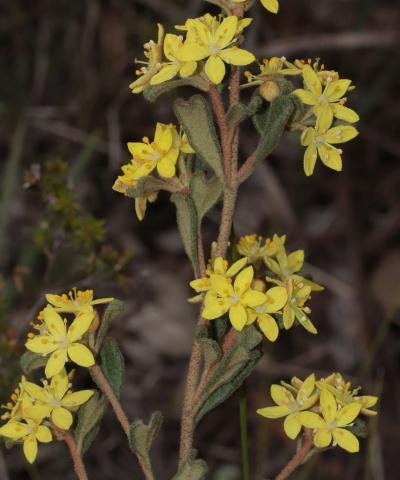A rare and critically endangered native shrub, Asterolasia rupestris subsp. recurva, has shown a remarkable population boost on a private property in the New England Tablelands, thanks to favourable weather conditions and ongoing conservation efforts.
Previously estimated at just 115 individual plants during a 2021 survey led by Saving our Species botanist Lachlan Copeland the population has now surged to an estimated 768 plants. A more recent survey of the property, conducted in April by NSW Biodiversity Conservation Trust ecologist Ben Vincent and landholder Stephen Walkden-Brown, revealed an encouraging number of seedlings.
Ben said the new plants were a very positive sign for the species.
“Although it wasn’t flowering season, the plant’s distinctive leaf colour and some early blooms helped with identification," Ben said.
Known locally as Lomalagi, after the property where it grows, Asterolasia recurva is restricted to a small creek line on Stephen’s property.

This year’s survey retraced the 2021 mapped route, adding two new monitoring points, and uncovering more than 600 seedlings, many of them estimated to be just two to three years old. The number of mature plants remains steady at a little more than 100.
Favourable climatic conditions since the end of the 2019 drought are believed to have contributed to the population increase. The last six summers have brought average to above-average rainfall, while the recent mild and wet autumn may have triggered rare out-of-season flowering in a few individuals.
However, despite positive signs, the population still faces threats.
Evidence that kangaroos, goats, deer and pigs have been enjoying the plant’s young tips, was found on several plants, but, encouragingly, some seedlings are benefiting from protective associations with neighbouring native shrubs, like Gaudium brevipes, commonly known as the slender tea-tree.
To support ongoing monitoring, permanent photo points have been established at key sites and Stephen is committed to keeping an eye on the rare plants. “The kind of private-public partnership we have with the BCT is essential for the recovery of species like Asterolasia recurva,” he said.
“We feel very fortunate to be custodians of this rare plant and even more so to witness it recovering.”
Ben’s ecological report recommends continued monitoring, protection from herbivores, with a focus on pest species control, and further research into the species’ ecology and its interactions with other native plants.
In 2024, Saving Our Species produced a conservation strategy template and DPIE funded the previous species survey and follow-up species distribution report in 2021. (Read more.)
About Asterolasia rupestris
Asterolasia rupestris subsp. recurva is a distinctive native shrub that grows up to 1.5 metres tall. It is distinguished by its heart-to triangular-shaped leaves covered in dense, star-shaped hairs and its bright yellow flowers.
Listed as Critically Endangered in NSW, this remarkable plant is known from only two small populations on private lands in the Parlour Mountains, northwest of Armidale.
All known individuals of this rare subspecies occur along creeklines in the Parlour Mountains within low open forest, growing in skeletal, gravelly loam soils derived from acid volcanic rock at an elevation of 1120–1150 metres.
With its entire population confined to a small location on private lands, Asterolasia recurva faces a high risk of extinction and is a clear priority for targeted conservation and ongoing landholder support.